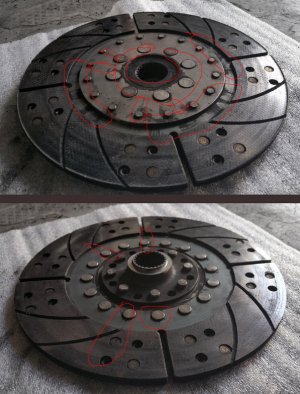2,000 or less miles on this clutch setup.
6xx whp - SOS TT
The car can BARELY move in gear. Slips past anything 2,000 RPM. Car drove fine prior. Perfect actually. It didn't gradually slip. One day, it decide it did not want to move any more. I have own and driven many high hp cars. I honestly know how this clutch should be driven, never do I leave my feet on the pedal any more then I need to. But all the clutch that have treated me well, usually slips only when I wear them down past the rivets. Not like this. (locally RPS has a hit and miss name, due to similar issues.) Carbon disc was design to take the heat better, last longer, and is stronger! But this seems to be not the case. I was briefly told from SOS that this is driver error or installation/adjustment. It's an insult, yet alone they completely forgot that the clutch was installed at SOS facility prior being stored. I honestly love the company and would want to work with SOS further on other NSX products, but this somewhat leaves a sour taste. 2,000 miles for something that was supposedly be something so great on longevity is unacceptable. I have own Exedy / OSgiken / ACT / Competition clutch over many years, and this is honestly the lowest operating clutch mile out there.
From inspection everything looked normal, other then little clutch dust. Only wear visible is the plate that comes in contact with the flywheel. There is plenty of meat life left on all disc.
http://i59.tinypic.com/212wnsz.jpg
http://i62.tinypic.com/10ydyco.jpg
http://i57.tinypic.com/2hf83ky.jpg
http://i62.tinypic.com/2h5ohti.jpg
http://i60.tinypic.com/adkdqt.jpg
http://i61.tinypic.com/24l7h2o.jpg <---only plate I see with wear, this is the one facing the flywheel (back side is fine, little to no wear)
http://i60.tinypic.com/v7tyd2.jpg
http://i62.tinypic.com/28lz4tl.jpg
http://i57.tinypic.com/2evyl5k.jpg
http://i62.tinypic.com/2w685fd.jpg
Here's a prestine example from a corvette owner. A "rebuild" will fix it, but there is no FLAW at all from these pictures and his own measurements.
http://www.corvetteforum.com/forums...57-rps-twin-disc-clutch-problem-pictures.html
Is there a design error we don't know about, where a "rebuild" will cure all bad problems?
My GUESS, its a weak pressure plate. I do know RPS has upgraded to something stronger over the years, secretly. - No fact guys. Just assumptions. Any ideas?
6xx whp - SOS TT
The car can BARELY move in gear. Slips past anything 2,000 RPM. Car drove fine prior. Perfect actually. It didn't gradually slip. One day, it decide it did not want to move any more. I have own and driven many high hp cars. I honestly know how this clutch should be driven, never do I leave my feet on the pedal any more then I need to. But all the clutch that have treated me well, usually slips only when I wear them down past the rivets. Not like this. (locally RPS has a hit and miss name, due to similar issues.) Carbon disc was design to take the heat better, last longer, and is stronger! But this seems to be not the case. I was briefly told from SOS that this is driver error or installation/adjustment. It's an insult, yet alone they completely forgot that the clutch was installed at SOS facility prior being stored. I honestly love the company and would want to work with SOS further on other NSX products, but this somewhat leaves a sour taste. 2,000 miles for something that was supposedly be something so great on longevity is unacceptable. I have own Exedy / OSgiken / ACT / Competition clutch over many years, and this is honestly the lowest operating clutch mile out there.
From inspection everything looked normal, other then little clutch dust. Only wear visible is the plate that comes in contact with the flywheel. There is plenty of meat life left on all disc.
http://i59.tinypic.com/212wnsz.jpg
http://i62.tinypic.com/10ydyco.jpg
http://i57.tinypic.com/2hf83ky.jpg
http://i62.tinypic.com/2h5ohti.jpg
http://i60.tinypic.com/adkdqt.jpg
http://i61.tinypic.com/24l7h2o.jpg <---only plate I see with wear, this is the one facing the flywheel (back side is fine, little to no wear)
http://i60.tinypic.com/v7tyd2.jpg
http://i62.tinypic.com/28lz4tl.jpg
http://i57.tinypic.com/2evyl5k.jpg
http://i62.tinypic.com/2w685fd.jpg
Here's a prestine example from a corvette owner. A "rebuild" will fix it, but there is no FLAW at all from these pictures and his own measurements.
http://www.corvetteforum.com/forums...57-rps-twin-disc-clutch-problem-pictures.html
Is there a design error we don't know about, where a "rebuild" will cure all bad problems?
My GUESS, its a weak pressure plate. I do know RPS has upgraded to something stronger over the years, secretly. - No fact guys. Just assumptions. Any ideas?
Last edited:











